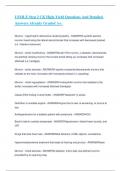USMLE Step 2 CK High-Yield Questions And Detailed
Answers Already Graded A+.
Murmur - hypertrophic obstructive cardiomyopathy - ANSWERA systolic ejection
murmur heard along the lateral sternal border that increases with decreased preload
(i.e. Valsalva maneuver)
Murmur - aortic insufficiency - ANSWERAustin Flint murmur, a diastolic, decrescendo,
low-pitched, blowing murmur that is best heard sitting up; increases with increased
afterload (i.e. handgrip)
Murmur - aortic stenosis - ANSWERA systolic crescendo/decrescendo murmur that
radiates to the neck; increases with increased preload (i.e. squatting)
Murmur - mitral regurgitation - ANSWERA holosystolic murmur that radiates to the
axillar; increases with increased afterload (handgrip)
Classic EKG finding in atrial flutter - ANSWER"Sawtooth" p waves
Definition of unstable angina - ANSWERAngina that is new, is worsening, or occurs at
rest
Antihypertensive for a diabetic patient with proteinuria - ANSWERACEI
Beck's triad for cardiac tamponade - ANSWERHypotension, distant heart sounds, and
JVD
Drugs that slow heart rate - ANSWERBeta-blockers, CCBs, digoxin, amiodarone
Hypercholesterolemia treatment that leads to flushing and pruritus - ANSWERNiacin
Murmur - mitral stenosis - ANSWERA diastolic, mid to late, low-pitched murmur
preceded by an opening snap
,Treatment for atrial fibrillation and atrial flutter - ANSWERIf unstable, cardiovert. If
stable or chronic, rate control with CCBs or beta-blockers
Treatment for ventricular fibrillation - ANSWERImmediate cardioversion
Dressler's syndrome - ANSWERAn autoimmune reaction with fever, pericarditis and
increased ESR occurring 2-4 weeks post-MI
IV drug use with JVD and holosystolic murmur at left sternal border. Treatment? -
ANSWERTreat existing heart failure and replace tricuspid valve
,Diagnostic test for hypertrophic cardiomyopathy - ANSWEREchocardiogram (showing a
thickened left ventricular wall and outflow obstruction)
Pulsus paradoxus - ANSWERA decrease in systolic BP of > 10 mmHg with inspiration;
seen in cardiac tamponade
Classic ECG finding in pericarditis - ANSWERLow-voltage, diffuse ST-segment
elevation
Definition of hypertension - ANSWERBP > 140/90 on 3 separate occasions 2 weeks
apart
Eight surgically correctable causes of HTN - ANSWERRenal artery stenosis, coarc of
aorta, pheo, Conn's, Cushing's syndrome, unilateral renal parenchymal dz,
hyperthyroid, hyperparathyroid
Evaluation of pulsatile abdominal mass and bruit - ANSWERAbdominal U/S and CT
Indications for surgical repair of abdominal aortic aneurysm - ANSWER>5.5cm, rapidly
enlarging, symptomatic, ruptured
Treatment for acute coronary syndrome - ANSWERASA, heparin, clopidogrel,
morphine, oxygen, sublingual nitro, IV beta-blockers
Metabolic syndrome - ANSWERAbdominal obesity, high triglycerides, low HDL,
hypertension, insulin resistance, prothrombotic or proinflammatory states
Appropriate diagnostic test: 50yo male with stable angina can exercise to 85% of
maximum predicted heart rate - ANSWERExercise stress treadmill with ECG
Appropriate diagnostic test: 65yo female with LBBB and severe OA has unstable angina
- ANSWERPharmacologic stress test (e.g. dobutamine echo)
Target LDL in a patient with diabetes - ANSWER<70mg/dL
, Signs of active ischemia during stress testing - ANSWERAngina, ST-segment changes
on ECG or decreased BP
ECG findings suggestive of MI - ANSWERST-segment elevation (depression means
ischemia), flattened T waves, Q waves
Coronary territories in MI - ANSWERAnterior wall (LAD/diagonal), inferior (PDA),
posterior (left circumflex/oblique, RCA/marginal), septum (LAD/diagonal)




